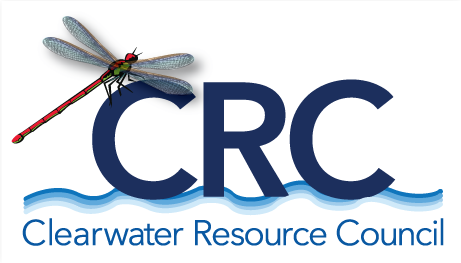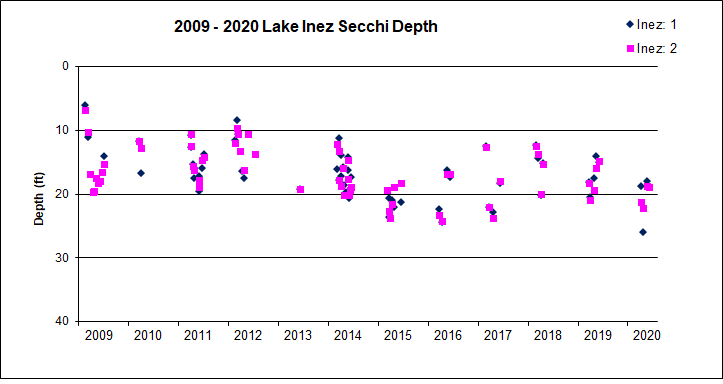Clearwater Lakes Alliance Information
Disclaimer: For a general intro to lake ecology and a list of terms used below, check out the CLA home page.
~ Lake Inez ~
Lake Inez (photo source)
Figure 1: Location of Lake Inez within the Clearwater Watershed
About Lake Inez
Located in the northern region of the Clearwater Watershed, just south of Lake Alva, Lake Inez is approximately 9 miles north of the town of Seeley Lake along Montana Highway 83 (Figure 1). The maximum depth of Lake Inez is approximately 72 feet.
Home to many desired native and introduced fish species, Lake Inez is a popular fishing spot in our watershed. Native fish species in Inez include mountain whitefish, westslope cutthroat trout, longnose sucker, and largescale sucker. Introduced species in Inez include kokanee salmon, northern pike, yellow perch, and brook trout.
Past Monitoring
Secchi and temperature have been measured on Lake Inez since 2009. This lake’s transparency is usually within the “mesotrophic” or “oligotrophic” depth boundary, with Secchi depth measurements typically between 10 and 20 feet (Figures 2 and 3).
Figure 2: Secchi depths recorded at 2 sites on Lake Inez from 2009 through 2020.
Figure 3: Secchi depths recorded at 15 sites on 8 lakes in the Clearwater Watershed, 2009 through 2020. The red and green lines represent the bounds for transparencies considered indicative of eutrophic and oligotrophic conditions, respectively. Note that as of 2020, Clearwater and Rainy Lakes were omitted from monitoring.
Dissolved oxygen (DO) was never monitored on Lake Inez until 2020. In 2020, CRC undertook DO monitoring on Lake Inez to give us a better idea of current conditions and whether water quality is declining. In addition to Lake Inez, DO profiles was taken on 5 other lakes in our watershed (Salmon, Seeley, Big Sky, Alva, and Placid) on a monthly basis throughout 2020 to establish a baseline DO dataset. This was an important step in better understanding the water quality changes that are likely taking place in our watershed.
Figure 4: Dissolved oxygen (mg/L) profile recorded at two sites in Lake Inez, from July through September 2020.
Figure 5: Temperature (°C) profile recorded at two sites in Lake Inez, from July through September 2020.
Monitoring sites 1 and 2 on Lake Inez are approximately 18 and 23 meters deep, respectively, and DO showed an initial sharp decrease at both sites at around 8-10 meters throughout the summer (Figure 4). The initial DO decrease was sharpest in September and most gradual in July. The thermocline (the depth where dramatic change in temperature occurs) remained at about 8 meters throughout the summer (Figure 5). DO below the thermocline decreased steadily from July through September. In July, DO levels remained relatively high below the thermocline, but by September, DO decreased to approximately 0 mg/L at about 12 meters at site 1 and 15 meters at site 2 (Figure 4). This pattern was common throughout the lakes: as the thermocline became more pronounced later in the summer, the oxygen deficit at depth was also more distinct.
Current and Future Monitoring
Water Quality
Figure 6: Water quality monitoring sites on Lake Inez in 2021.
Drawing conclusions based upon the sporadic data that currently exists prior to 2020 is difficult, and more consistent measurements are needed to better assess the status of each lake in the valley. In 2021, CRC is collecting data on DO, conductivity, algae, nutrient, and pH conditions on Lake Inez (as well as Alva, Big Sky, Placid, Salmon, and Seeley) in order to continue establishing baseline data to aid in future water quality analyses. We will also be analyzing data to evaluate the health of our aquatic ecosystems in the Valley. This includes looking for trends in Nitrogen and Phosphorous levels, presence of E. coli bacteria, evidence of oxygen depletion, growth of potentially toxic algae, and other changes to the waterbodies in the Clearwater Watershed.
A new addition to the monitoring process this year is a multiparameter water quality monitoring instrument. This new piece of equipment was recently purchased thanks to a Bureau of Reclamation WaterSMART grant. It uses sensors to accurately read and record levels of conductivity, algae, and pH as deep as 30 meters (~100 feet) in our lakes. Such data is integral to determining the health of our lakes here in the Clearwater Watershed and can aid in detecting harmful algal blooms and habitat degradation.
Check back in the winter for results and findings from our monitoring season!
Aquatic Invasive Species (AIS)
Zebra and Quagga Mussels
Figure 7: 11 lakes in the Swan, Clearwater, and Blackfoot drainage basins were monitored for AIS in 2020. In order, as labeled, these lakes include: Holland, Lindbergh, Alva, Inez, Seeley, Placid, Big Sky, Salmon, Upsata, Coopers, and Browns.
CRC has been monitoring for invasive species in the Clearwater Watershed throughout the summers since 2009 on each of the major lakes in the Valley (Alva, Inez, Seeley, Salmon, Placid and Big Sky). One of the biggest threats to Montana’s waterways is the introduction of zebra and quagga mussels, collectively referred to as dreissenid mussels. The purpose of our AIS program is to monitor for the presence of veligers in the lakes by straining large volumes of lake water through a fine mesh net to collect planktonic and microscopic materials in the lake water, including mussel veligers, if present. Veligers are the free-swimming, microscopic juveniles of zebra and quagga mussels. Over the course of the 2020 field season, 62 total sites, spread out over 11 lakes (Figure 7), were sampled each round, totaling 310 samples.
We are happy to report that zebra and quagga mussel veligers were undetected in all of the samples collected and analyzed in 2020. We will continue to monitor for zebra and quagga mussel veligers throughout 2021 on the six major lakes in the Valley.
Fragrant Waterlilies
Another problematic invasive species in the Clearwater Watershed is the non-native Fragrant Waterlily. The Fragrant Waterlily was likely introduced to the region as an ornamental plant, but has since experienced exponential population growth. The mats of these waterlilies are detrimental to aquatic habitat and outcompete native plant species. Fragrant waterlilies can also cause oxygen depletion, which negatively affects native fish and amphibian species. In 2020, the Missoula County Weed District mapped the waterlilies on the major lakes in the Clearwater, recording a total of 6.83 acres of the species on Lake Inez.
Throughout Summer 2021, CRC held both lily digging and cutting events on Seeley Lake in an effort to remove the invasive species from our watershed. Lake Inez residents and homeowners gathered to do the lake’s first lily cut this summer. This is a multi-level complex process, and additional removal efforts are planned for more lakes in the upcoming years.
Through CLA, we hope to involve more residents in our citizen science Adopt-a-Lake program to expand the parameters we monitor and increase our monitoring frequency. CLA will also help us to take steps to actively improve the water quality of the lakes, which over time will hopefully be evident through the monitoring data we collect.
Establishing baseline monitoring data through our Adopt-a-Lake program is only the start. Contact CRC’s Jon Haufler ( jon@crcmt.org) to learn more about current efforts and/or how you can get involved.
Return to Clearwater Lakes Alliance main page.
Last updated September 2021








